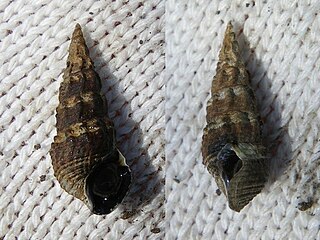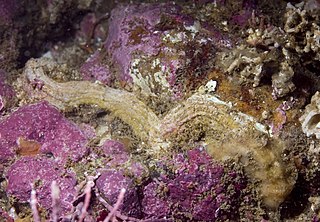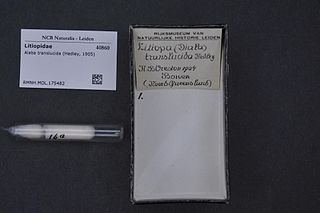
The order Cephalaspidea, also known as the headshield slugs and bubble snails, is a major taxon of sea slugs and bubble snails, marine gastropod mollusks within the larger clade Euopisthobranchia. Bubble shells is another common name for these families of marine gastropods, some of which have thin bubble-like shells. This clade contains more than 600 species.

Caenogastropoda is a taxonomic subclass of molluscs in the class Gastropoda. It is a large diverse group which are mostly sea snails and other marine gastropod mollusks, but also includes some freshwater snails and some land snails. The subclass is the most diverse and ecologically successful of the gastropods.

Potamididae, common name potamidids are a family of small to large brackish water snails that live on mud flats, mangroves and similar habitats. They are amphibious gastropod molluscs in the superfamily Cerithioidea.

Zeacumantus is a genus of small to medium-sized sea snails or mud snails, marine gastropod mollusks in the family Batillariidae.

Zeacumantus subcarinatus, common name the southern creeper, is a species of small sea snail or mud snail, a marine gastropod mollusc in the family Batillariidae.

Batillaria is a genus of small salt marsh or mudflat snails, marine gastropod mollusks in the family Batillariidae, the horn snails.

The Vermetidae, the worm snails or worm shells, are a taxonomic family of small to medium-sized sea snails, marine gastropod molluscs in the clade Littorinimorpha. The shells of species in the family Vermetidae are extremely irregular, and do not resemble the average snail shell, hence the common name "worm shells" or "worm snails".

Thiaridae, common name thiarids or trumpet snails, is a family of tropical freshwater snails with an operculum, aquatic gastropod mollusks in the superfamily Cerithioidea.

Cerithiidae, common name the cerithiids or ceriths, is a large family of medium-sized marine gastropods in the clade Sorbeoconcha.

The Cerithioidea is a superfamily of marine, brackish water and freshwater gastropod containing more than 200 genera. The Cerithioidea are included unassigned in the subclass Caenogastropoda. The original name of this superfamily was Cerithiacea, in keeping with common superfamily endings at the time.

Pachychilidae, common name pachychilids, is a taxonomic family of freshwater snails, gastropod molluscs in the clade Sorbeoconcha.

Diastomatidae is a family of sea snails, marine gastropod molluscs in the superfamily Cerithioidea.

Litiopidae, common name litiopids, is a family of small sea snails, marine gastropod molluscs in the clade Sorbeoconcha.

Modulidae, common name modulids, is a family of small sea snails, marine gastropod molluscs in the superfamily Cerithioidea.
This overview lists proposed changes in the taxonomy of gastropods at the family level and above since 2005, when the taxonomy of the Gastropoda by Bouchet & Rocroi (2005) was published. In other words, these are recent updates in the way various groups of snails and slugs are classified.

Batillaria australis is a species of sea snail, a marine gastropod mollusk in the family Batillariidae.

Lampanella is a genus of sea snails, marine gastropod mollusks in the family Batillariidae.

Pyrazus is a genus of sea snails, marine gastropod mollusks in the family Batillariidae. Pyriazidae is a synonym of Batillariidae and Pyrazus is the type genus of the Pyriazidae.

Rhinocoryne is a genus of sea snails, marine gastropod mollusks in the family Batillariidae.
Obtortionidae is a family of sea snails, marine gastropod molluscs in the superfamily Cerithioidea, that is within the clade Cerithimorpha or in clade Sorbeoconcha.

















